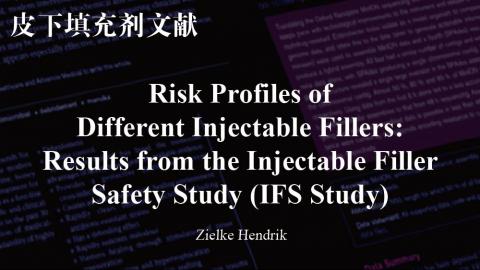
- 2368人
- 分享收藏
Risk Profiles of Different Injectable Fillers: Results from the Injectable Filler Safety Study (IFS Study)
Zielke Hendrik
简介
【 文献重点摘要 】
Background: Injectable fillers are widely used in aesthetic medicine. Although most materials are considered to be safe, adverse events occur. Our knowledge on frequency and potential risk factors is limited.
Objective: The aim of this study was to describe adverse reactions to injectable fillers based on a partly population-based case series.
Methods: Dermatologists, plastic surgeons, and maxillofacial surgeons in Berlin were asked to report patients with adverse reactions. Additional patients were obtained from a private practice. A standardized questionnaire was used to assess all data. All data were analyzed by descriptive measures.
Results: Fifty-six patients (age, 48 ± 11.2 (SD) years) who had been treated with nine different fillers were assessed. In 48 patients treated with only one filler, 167 areas had been treated. In 129 (77.3%) areas adverse reactions occurred 12.2 ± 15.6 (SD) months after injection. Adverse reactions to biodegradable fillers occurred after 4.9 ± 5.8 (SD) months, and reactions to nonbiodegradable fillers after 18.3 ± 19.0 (SD) months (p= .005). As adverse events, continuing pain, swelling, nodules, pigmentation, abscess formation, and erythema were found.
Conclusion: Adverse reactions can be documented for all injectable fillers. Time until reaction as well as type of reaction, however, vary between different fillers. Further research is necessary to evaluate potential risk factors.
背景:可注射填充物在美容医学中应用广泛。虽然大多数材料被认为是安全的,但不良事件还是会发生。我们对频率和潜在风险因素的了解有限。
目的:本研究的目的是根据部分以人群为基础的病例系列,描述注射性填充剂的不良反应。
方法:对柏林的皮肤科医生、整形外科医生和颌面外科医生进行不良反应报告。更多的病人是从一家私人诊所获得的。采用标准化问卷对所有数据进行评估。所有数据均采用描述性方法进行分析。
结果:56例患者(年龄48±11.2岁,SD)接受了9种不同填充物的治疗。在48例仅用一种填充物治疗的患者中,有167个区域得到了治疗。129个地区(77.3%)在注射后12.2±15.6个月(SD)出现不良反应。可生物降解填充物的不良反应发生在4.9±5.8(SD)个月后,不可生物降解填充物的不良反应发生在18.3±19.0(SD)个月后(p=0.005)。不良反应包括持续性疼痛、肿胀、结节、色素沉着、脓肿形成和红斑。
结论:所有注射型填充物的不良反应均可记录在案。然而,反应前的时间以及反应的类型在不同的填料之间是不同的。有必要进行进一步的研究,以评估潜在的风险因素。



